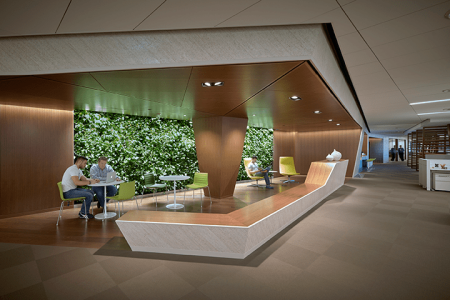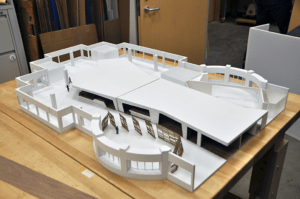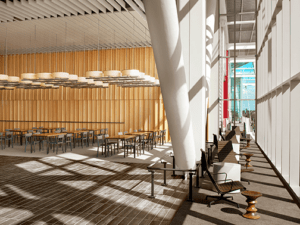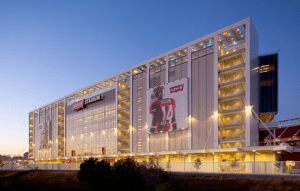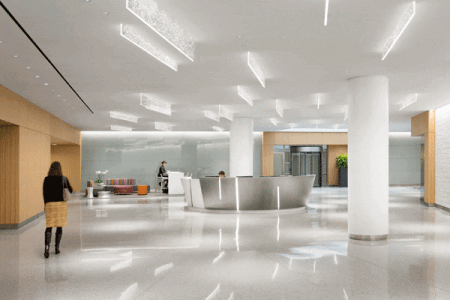For nearly a decade and a half, A. Eugene Kohn, founder and chair of New York City–based design firm Kohn Pedersen Fox Associates (KPF), has taught at Harvard’s Graduate School of Design and other institutions, including the University of Pennsylvania, the University of California at Los Angeles, and the Harvard Business School. “I like inspiring and helping people to be successful,” he says. “I enjoy watching young architects mature, grow, develop, become leaders, and accomplish great things.”
Teaching at such prestigious schools has an additional benefit: it enables KPF to pursue young talent. “When a firm has a presence on campus, it’s natural to forge relationships with the students and identify young architects who are a good fit for the company,” Kohn explains. “Jamie von Klemperer, KPF president, and Forth Bagley, principal, both teach at Yale. Targeting universities for recruitment has been made easier by our involvement in these schools.”
Attracting talent is one of the major challenges that the architecture, engineering, and planning (AEP) sectors face in the years ahead. There are others, including industry consolidation, rapidly changing technology, cyber security issues, and the constant need to generate new business. The American Institute of Architects’ Foresight Report, developed with the Colorado-based Greenway Group to highlight key trends in the marketplace and their impact on business, noted that the design and construction industries are approaching a period of profound transformation. Talent shortages driven by demographics and the 2008 recession are colliding with greater worker mobility and a history of flat compensation rates. The report, issued in 2014, added the following: “New technologies, from 3-D printing to mobile and cloud computing, are spurring innovation and transforming the way we work, create, and structure our firms. The needs of an increasingly diverse workforce are challenging traditional management and human resource models and bringing new voices to the table.”
According to Fayetteville, Arkansas–based consulting and publishing firm Zweig Group’s 2016 Merger and Acquisition (M&A) survey of AEP and environmental consulting firms, of all responding, 47 percent reported that they were considering M&A activity over the next five years—up from 42 percent last year. Of those, 32 percent said they were looking at acquisitions, while 15 percent were eyeing a merger or an acquisition. Thirty-eight percent said they were considering neither a merger nor an acquisition.
Technological advances such as 3-D printing and cloud computing also are buffeting the sector. Three-dimensional printing could be a game-changer in the way that construction documents are produced. “One can move from design development drawing documents directly to 3-D-printing a full-scale structure,” says Lira Luis, chief collaboration architect at Chicago’s Atelier Lira Luis.
“Since the architecture profession is not prone to be an early adopter of new technology, cloud technology poses adoption roadblocks,” she adds. “It took a while, with much debate and resistance, for architects to transition from hand drawings to computer-aided drawing [CAD] and subsequently from 2-D CAD to 3-D CAD. I foresee a similar reaction to cloud technology, though there are pioneers in the profession who could enable it to eventually become mainstream. Digital fabrication services of scaled models and full-scale mock-ups are now part of the new services offered by some firms as a result of 3-D printing technology. Some are also offering virtual-reality designs.”
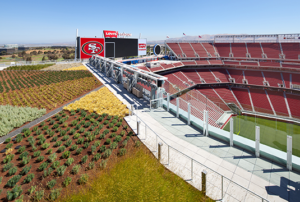
HNTB designed the $1.2 billion, 68,500-seat Levi’s Stadium in Santa Clara, California—one of the NFL’s most innovative, sustainable, and technologically advanced stadiums—as an expandable sports and entertainment destination. Construction started in April 2012, and the stadium opened in July 2014, becoming the NFL’s fastest-built stadium. (© HNTB)
Identifying new sources of revenue also is a concern. Many U.S. planning firms are increasing business by providing services to public sector clients who downsized during the 2008 recession and who have been slow to replace the positions they eliminated, says Deborah L. Myerson, a planning consultant and chair of the private practice division for the Washington, D.C.–based American Planning Association. “Private planning consultants help supplement public agency staff, offering specialty services and meeting pressing deadlines,” she says. “In particular, engineering and design firms have sought to grow their planning services in-house to be more competitive and to add to their capabilities. Larger engineering and design firms are frequently teaming with independent planning consultants to broaden their expertise for a specific project.”
Added to this mix is a concern about global security. “Recently, we learned that a number of architecture firms experienced ransomware attacks—malicious software designed to block access to a computer system until money is paid—that shut their systems down for days, and weeks in one case,” says Ted Hyman, managing partner of ZGF Architects. “Ransomware attacks can cost far more than the original ransom requests when you consider the labor and delay costs to repair the damage.”
Firm Consolidation
Consolidation is expected to continue domestically and globally, says Frederick A. Kramer, vice president and regional buildings leader for the Northeast at multidisciplinary design firm Stantec. He speaks from experience: Kramer was president of ADD Inc., a Boston architecture, interior design, and planning firm that merged with Stantec two years ago. “Naturally, success depends on the culture of the two firms,” he says. “It can be a difficult roller-coaster ride for midsized design companies. Today, the pressures of commoditization and design firm congestion—too many firms in too little space—are ever present.”
The slowly improving global economy has resulted in an increased pace of mergers and acquisitions as firms seek to become one-stop shops by providing full-service design, building, and engineering services, or to find niche markets that will allow them to grow revenue. Smaller firms vying for business in a market where their competitors have already completed a merger are offering more comprehensive solutions to clients. These smaller firms feel as though they are at a disadvantage and are looking to bulk up as well to match what their competitors can offer.
Succession Planning
Succession is also spurring M&A activity in the sector. Many small to medium-sized AEP firms have not developed their next generation of leaders and are looking elsewhere to provide their firms with continuity. “There are many firms that were founded in the last 30 to 40 years that were very successful under their original leadership. However, they did not plan for transition,” Hyman says. “As a result, there has been a large number of acquisitions that happened as an exit strategy more than as a response to the market.”
Combining companies, though, is not suitable for all firms. Kohn Pedersen Fox Associates has never viewed acquisitions as a growth strategy, Kohn says. “If a firm has a specialty we feel necessary to gain expertise in, we’ve pursued specific people with those skills and knowledge rather than buying entire firms,” he says. “The culture of firms can be quite different and cause considerable problems when competing and/or joining together.”
When companies consolidate, they can lose the shared beliefs and values of the original organization, agrees Bill Hellmuth, president of HOK and design principal for its D.C. office. “Endless consolidation by acquisition makes it very difficult to maintain the best parts of your culture,” he says. “I think firms that are going to survive will do so less by consolidation and more by organic growth because they have a better chance of preserving the culture that made them terrific in the first place.”
Not only that, but boutique design practices can often offer more flexibility, less staff anonymity, and unique familiarity with their particular localities, points out Michael E. Liu, vice president and principal of the Architectural Team, based in Chelsea, Massachusetts. “For that reason, it is likely that boutique practices will continue to survive in spite of these pressures,” he says.
Attracting the Best Talent
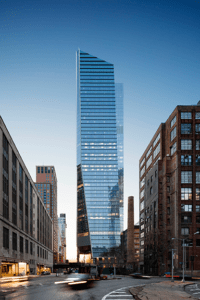
Kohn Pedersen Fox Associates of New York created the master plan for the 13 million-square-foot (1.2 million sq m) Hudson Yards mixed-use development in New York City, a project of Related Companies and Oxford Properties Group. The new 26-acre (10.5 ha) neighborhood is being built on two platforms above the Long Island Rail Road rail yard. KPF also designed the 10 Hudson Yards project, which opened in June, as well as 30 Hudson Yards, expected to be completed by the end of 2017. (© raimund koch)
Even as consolidation continues as a trend, AEP firms must also contend with the need to fill positions. Tim Cahill, chief design officer and senior vice president at Kansas City, Missouri–based HNTB Architecture, which focuses on the aviation, transit, and sports sectors, recalls attending an American Institute of Architects (AIA) large-firm roundtable as a member “and everybody had the same concern—how to recruit new people, how to keep the millennials interested, and how to retain them,” Cahill recalls. “Most of the participants were in their 50s, and many had worked at two or three companies in their lives. They were shocked that millennials might work at 15 firms during their career. Millennials are not afraid to change jobs, and [imbuing] them with a sense of loyalty—and retaining them—is a huge challenge.”
There also is added competition for the best and the brightest from outside the AEP sector. “Graduates of architectural schools now think nothing of going to work for Disney or Google,” Cahill says. “Paying people more doesn’t seem to be the solution, so companies are becoming more creative. They are offering low-interest loans to help graduates with high-interest-rate debt or maybe having a financial adviser on staff since a lot of people fresh out of college have huge student loans; the adviser can recommend ways to pay [that debt] off.”
Perhaps such creative efforts are beginning to pay off. According to the U.S. Department of Labor’s Bureau of Labor Statistics, 2.846 million people were employed in the architecture and engineering occupations in 2012. That figure dipped 1.4 percent to 2.806 million a year later and was further reduced to 2.798 million in 2014. However, last year, employment levels that had lost ground recovered and surpassed the 2012 level, with the employment figure rising to 2.954 million.
Yet an AEP company has finite resources, Hellmuth says. “The differentiator today is what a firm spends its time doing in stimulating and meaningful ways and making a contribution to the world,” he says. “By getting interesting and meaningful projects, you can provide an environment where younger people know they can thrive and grow in the firm.”
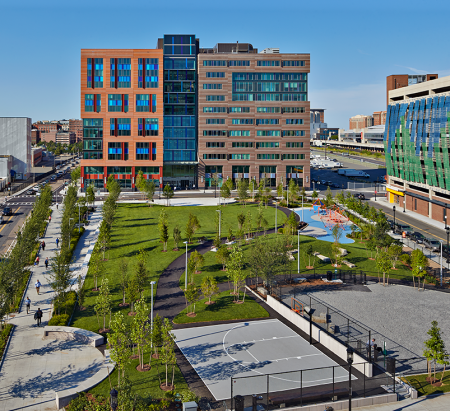
Boston-based Stantec Architecture designed One Channel Center, a 538,000-square-foot (50,000 sq m) project for Commonwealth Ventures, using the latest technological tools. Located in Boston’s Innovation District, the structure incorporates strategic sustainable design practices to achieve Leadership in Energy and Environmental Design (LEED) Silver certification. (© Robert Benson Photography)
One of the best ways to attract talent is to have great clients who demand innovative projects, especially those that have a larger impact on the social and environmental issues facing communities and the planet. “After that,” Hyman says, “it is essential to provide the talent with the opportunities to excel in their careers. It means mentoring and providing opportunities to contribute in meaningful ways, and it is critically important for them to collaborate with others who are interested in innovation.”
Some firms are also implementing programs to encourage recent graduates and emerging professionals by supporting their membership in organizations such as the American Institute of Certified Planners (AICP) or earning professional certifications to enhance employees’ skills and foster their loyalty. “Encouraging professional development at conferences and workshops provides valuable face time that promotes the firms as well as the individual,” Myerson says. “As a colleague recently told me, ‘Employees are your big investment. It’s important to offer them educational opportunities and keep them motivated.’”
The latest innovative and advanced digital technologies also can attract talent. KPF uses the most recent building information modeling (BIM) applications, rendering, and in-house 3-D printing technologies, as well as a host of virtual- and augmented-reality platforms. “In addition, we stress programming and custom-build applications, leveraging these tools to optimize and refine our design solutions,” Kohn says. “Younger architects are graduating with stronger and more sophisticated technology skills. We want to build on those skills through training and applied experience, while reinforcing this technology-driven approach to programming and design.”
Leveraging youth is another way to lure talent. “If we have a 20-something who is immensely talented but not that experienced, we’ll make sure she collaborates alongside a more senior practitioner,” says Gordon R. Carrier, design principal at San Diego–based design firm Carrier Johnson + CULTURE. “Millennials have the ability to think in ways we believe might benefit our clients, so we’ll leverage that talent whenever it’s appropriate. A great idea is a great idea, no matter who it comes from.”
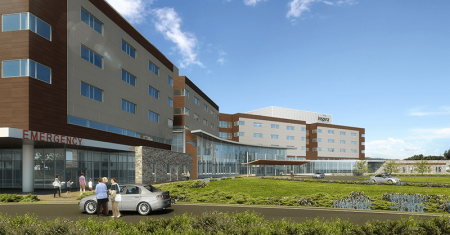
Skanska has been hired to build a $200 million hospital for the Inspira Health Network in Mullica Hill, New Jersey. The 134,000-square-foot (12,400 sq m), 204-bed hospital will house operating rooms, an emergency department, and imaging suites, as well as administrative, dining, and support services. Construction will begin in the first quarter of 2017 and is scheduled to be completed by December 2019. The project includes construction of a new central utility plant, which will provide electricity, heating/hot water, and chilled water. (© array architects)
Construction firms face even more hurdles in attracting team members. Bill Flemming, president and chief executive officer of Skanska USA Building, a development and construction company based in New York City, says that during the last recession, people left the construction field. “It’s a real contest to find qualified people nowadays,” he says. “The construction industry has a bad rap, and younger people think it’s difficult, hard manual labor, but it’s more than that. We need to get that message out.”
The industry can offer employees more of a career path than they might expect. Nowadays, Skanska personnel link up with their alma maters to work with students early in their careers, visit trade schools to talk about how the industry has evolved, and cooperate closely with unions to set up appropriate apprenticeship programs and training in the field. The company offers extended maternity leave for employees starting families as well as educational assistance for undergraduate and postgraduate studies for those expanding their knowledge, Flemming says. Plus, the company offers opportunities to work across its business units in the United States and globally.
Tackling Technology
More than ever, today’s AEP firms need to be at the forefront of their field and deliver cutting-edge technology. “We design billion-dollar sports stadiums and we use 3-D modeling, virtual reality, and all the other tools,” Cahill says. “Just making a presentation sometimes can cost $300,000. Communications is important. When we designed the [San Francisco] 49ers [football] stadium, various HNTB architects across the country were involved, along with numerous contractors and subconsultants located in a number of cities, so we had to set up design matrixes and make design decisions to stay ahead of all the trades. The key is to have everyone together from day one so the owner, contractor, architects, and others are a team—everyone is on the same page and everything is designed and built at the same time to keep costs down and quality up.”
Five years ago, 3-D model fabrication was an expensive proposition. “However, it has now become so ubiquitous that we have small plotters for individual teams to use for quick prototyping,” Hyman says. “Today, we are using virtual-reality modeling not just to play a role in presentations to clients, but also as a real-time design tool. Not only is the quality of the tools improving very rapidly, but also the costs of the cameras and support equipment are more affordable, making virtual-reality modeling available to essentially everyone.”
Virtual reality–simulated environments, combined with drone photography, already are beginning to change how designers handle the design process and potentially construction, says Claire Weisz, principal in charge at WXY architecture + urban design in New York City. “Another big challenge is extrapolating current data with changed conditions. That means we need better ways to aggregate, parse, mine, and then create models that our private and public clients need in their businesses and communities. These are very disruptive technologies.”
Technology today offers fresh ways to gather community input and inform the decision-making process. Planners—whether they work in land use, transportation, or economic development, or for a large city, a suburb, or a small town—have become more aware of emerging trends and technologies such as automated vehicles, cost-effective resilient design, and biometric applications for healthier living. “Virtual reality can allow users to ‘experience’ how proposed changes to a community would look or feel,” Myerson says. “In transportation planning, drones have been used to assess transportation infrastructure. Widespread broadband infrastructure can support the collection of real-time data through infrastructure sensors. And mobile apps, social media channels, and other technological advances are enhancing community engagement with multiple modes of outreach.”
Videoconferencing has become increasingly important, Hellmuth notes. “When it first came out, I called it ‘jerk-a-vision’ because there wasn’t enough bandwidth and it was jerky and difficult to watch,” he recalls. “But today, videoconferencing is seamless and it provides us the ability to collaborate with others. It’s right up there with the mobile phone: you take a photo of a sketch and send it to someone thousands of miles away. It may be mundane, but it allows communications to occur instantaneously.”
The technology explosion will provide even more tools for designers to meet the needs of their clients quickly and more clearly, Kramer says. “The client’s pace of business is becoming so dynamic that the nature of our buildings and places that we create needs to be more sustainable, more adaptable, and more invigorating than ever. The design profession has typically been relatively slow to respond, but the demographic changes are helping to drive some of these changes, both on the client and on the design team side.”
Mike Sheridan is a freelance writer based in Richmond, Virginia.

